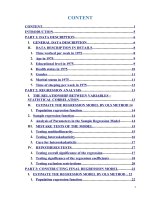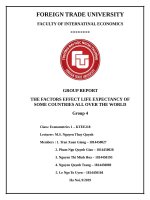tiểu luận kinh tế lượng tài chính factors affecting the human development index over the world in 2017
Bạn đang xem bản rút gọn của tài liệu. Xem và tải ngay bản đầy đủ của tài liệu tại đây (1.14 MB, 39 trang )
FOREIGN TRADE UNIVERSITY
FACULTY OF INTERNATIONAL ECONOMICS
ECONOMETRICS REPORT
Factors affecting the Human Development Index over the world in 2017
Group:
1. Trinh Thi Hong Nhung – ID: 1813340049
2. Nguyen Hoang Ha – ID: 1813340023
3. Vu Phuong Linh – ID: 1813340036
4. Pham My Duyen – ID: 1813340019
5. Nguyen Binh An – ID: 1713340002
6. Dao Minh Hoa – ID: 1212340030
Class:
KTEE301.1 (21/10-15/12/2019)
Instructors: Dr. Nguyen Thuy Quynh
Hanoi, December 2019
FOREIGN TRADE UNIVERSITY
FACULTY OF INTERNATIONAL ECONOMICS
ECONOMETRICS REPORT
Factors affecting the Human Development Index over the world in 2017
Group
1. Trinh Thi Hong Nhung – ID: 1813340049
2. Nguyen Hoang Ha – ID: 1813340023
3. Vu Phuong Linh – ID: 1813340036
4. Pham My Duyen – ID: 1813340019
5. Nguyen Binh An – ID: 1713340002
6. Dao Minh Hoa – ID: 1212340030
Class:
KTEE301.1 (21/10-15/12/2019)
Instructors: Dr. Nguyen Thuy Quynh
Hanoi, December 2019
TABLE OF CONTENT
ABSTRACT
We are living in a complex world. People, nations and economies are more connected than
ever, and so are the global development issues we are facing. These issues span borders,
straddle social, economic and environmental realms, and can be persisting or recurring.
From urbanization to the creation of jobs for millions of people, the world’s challenges
will only be solved using approaches that take both complexity and local context into
account. For almost thirty years, UNDP’s human development approach—with its
emphasis on enlarging people’s freedoms and opportunities rather than economic growth
—has inspired and informed solutions and policies across the world.
In hope of providing a deeper insight, scrutinizing a specific case, our group would like to
take the topic “Factors affecting the Human Development Index over the world in
2017” in thorough consideration. This report investigates the determinants of Human
Development Index in 120 countries, employing the methods of panel data analysis. Due
to the limited of data resources, we can only pick up a few prominent factors of those
countries in 2017, which are Life expectancy at birth (LE), Expected years of
schooling (EYS) - mean years of school, Gross national income (GNI) per capita,
Inflation rate (INF) and Fertility rate (FER). Our research indicates that the relationship
between human development index and three factors which are GNI per capita, inflation
rate (INF), fertility rate (FER) is negative. A reverse tendency could be observed in the
relationship between HDI and life expectancy at birth (LE), expected years of school
(EYS), as they are positive.
INTRODUCTION
Econometrics is the quantitative application of statistical and mathematical models using
data to develop theories or test existing hypothesis in economics and to forecast future
trends from historical data. It subjects real-world data to statistical trials and then
compares and contrasts the results against the theory or theories being tested.
Depending on whether you are interested in testing an existing theory or in using existing
data to develop a new hypothesis based on those observations, econometrics can be
subdivided into two major categories: theoretical and applied. Those who routinely engage
in this practice are commonly known as econometricians.
In the report, we will use the econometric model to find out the relationship between by
using collected data from World Bank, UNDP and others sources, whether they have
positive or negative relationship. And from the result, we may have some
recommendations to countries with lower human development index.
We recognize the important of econometrics in social economics. In order to understand
how the econometrics works in real life and to apply econometrics effectively and
correctly, our group would like to develop a report under the guidance of Dr. Nguyen
Thuy Quynh. In this report, we used the econometrics analysis tool Stata to analyze the
topic “Factors affecting the Human Development Index over the world in 2017”
The report contains the following contents:
•
SECTION 1: OVERVIEW OF THE TOPIC
•
SECTION 2: MODEL SPECIFICATION
•
SECTION 3: ESTIMATED MODEL AND STATISTICAL INFERENCES
•
CONCLUSION
•
APPENDIX
•
INDIVIDUAL ASSESSMENT
During the process of making this report, due to the limited amount of time as well as
some certain limits in understanding and data collecting, despite all the efforts, the report
may hardly avoid mistakes. We are always willing to receive your comments so that our
group can improve and complete this report.
Many thanks!
SECTION 1.
1.
OVERVIEW OF THE TOPIC
The Human Development Index (HDI)
The Human Development Index (HDI) is a composite statistic of life expectancy,
education, and per capita income indicators, which are used to rank countries into four
tiers of human development. A country scores higher HDI when the lifespan is higher, the
education level is higher, the GDP per capita is higher, the fertility rate is lower, and the
inflation rate is lower.
1.1. HDI stands for Human Development Index.
It was developed and launched by Pakistani economist Mahbub-ul-Haq, followed by
Amartya Sen, an Indian economist, in 1990. Human Development Index, HDI, is a
comprehensive tool devised by the United Nations for measuring the levels of social and
economic developments of the different countries and ranking them accordingly. It is a
comparative measure of life expectancy, education, literacy, and standard of living.
Essentially, Human Development Index, HDI, makes use of four parameters for measuring
and ranking countries according to their social and economic development which includes
the Life Expectancy at Birth, Expected Years of Schooling, Mean Years of Schooling and
Gross
National
Income
per
Capita.
There are two steps to calculating the HDI:
1.1.1. Forming indices for each of the four metrics
The values of each of the four metrics are first normalized to an index value of 0 to 1. To
do this, “goalposts” of the maximum and minimum limits on each metrics are set by the
UNDP, as shown in the table. With the actual value for a given country, and the global
maximum and minimum, the dimension (indices) value for each metric is calculated as:
The dimension index is therefore 1 in a country that achieves the maximum value and it is
0 for a country that is at the minimum value.
1.1.2. Aggregating the four metrics to produce the HDI
Once each of the individual indices has been calculated, they are aggregated to calculate
the HDI. The HDI is calculated as the geometric mean (equally-weighted) of life
expectancy, education, and GNI per capita, as follows:
The education dimension is the arithmetic mean of the two education indices (mean years
of schooling and expected years of schooling).
1.2. Economic theories
The main purpose of our group’s research is to determine the factors which affect the
fluctuation of The Human Development Index (HDI). However, we will mainly focus on
the long-term relationship between those factors and HDI. According to previously
published researches, some long-term factors substantially affecting HDI are Life
expectancy at birth, expected years of schooling, Gross national income (GNI) per capita,
Inflation, and Fertility.
1.2.1. The effect of Life expectancy at birth on HDI
Life expectancy at birth (years) is the average number of years a newborn child would live
if
current
mortality
patterns
were
to
stay
the
same.
According to Max Roser in an article on “Our World in Data” website, the first component
of the HDI – a long and healthy life – is measured by life expectancy. Long-run estimates
of life expectancy across the world are shown in the visualization. For countries where
historical records are available, such as the UK, estimates can extend as far back as 1543 –
click on the UK to see this long-run perspective. Global and regional estimates extend
back to the year 1770. This dataset is based on a combination of data from the Clio Infra
project, the UN Population Division, and global and estimates for world regions from
James Riley (2005)
1.2.2. The effect of Expected years of schooling on HDI
The second component – access to education – is measured by expected years of
schooling of children at school-entry age and mean years of schooling of the adult
population.
Education has been one of the most integral drivers and outcomes of global development.
The provision of education is now viewed in most parts of the world as a basic right –
with pressure on governments to ensure a high-quality education for all.
Education should have a positive effect on HDI because as education increases so does the
knowledge of how to lead a healthier life. This knowledge might, for example, take the
form of improved nutrition or reduced exposure to various health risks, such as indoor
pollution exposures. Education is measured by the education index. In this analysis, the
Total literacy rate has been taken as a proxy of Education index.
There are many metrics we can use to assess education access, quality, and attainment –
we
cover
many
of
them
throughout
our
work
on
education
The visualizations present the two metrics that the HDI captures:
- Mean years of schooling estimates the average number of years of total schooling adults
aged 25 years and older have received. This data extends back to the year 1870 and is
based on the combination of data from Lee and Lee (2016); Barro-Lee (2018); and the UN
Development
Programme.
- Expected years of schooling measures the number of years of schooling that a child of
school entrance age can expect to receive if the current age-specific enrollment rates
persist throughout the child’s life by country.
1.2.3. The effect of Gross national income (GNI) per capita on HDI
The architects of the HDI have decided to add a third dimension – a decent standard of
living – and to measure it by Gross National Income per capita.
GNI is expected to be positively related to HDI for diverse reasons. GNI displays
disposable income. As disposable income increases, people have more resources for better
shelter, food, and medical care. Again, countrywide data might offer some advantages
over individual data: a wealthy person living in a poor country is unlikely to have the
same access to quality food and medicine as a wealthy person living in a wealthy country.
Since income is highly correlated with many other categories that would affect HDI (e.g.
education, life expectancy), it is also held constant to estimate, without bias, the specific
effects
of
those
variables.
For most of human history, our ancestors were stuck in a world of poor health, hunger and
little access to formal education. Economic growth – particularly over the past few
centuries – has allowed some part of the world population to break out of these conditions.
The map shows the GNI per capita - this is the metric that the HDI relies on:
1.2.4. The effect of Fertility on HDI
Total Fertility rate (Children per woman): The number of children that would be born to
each
woman
with
prevailing
age-specific
fertility
rates.
where
ASBR
is
each
five-year
age-specific
birth
rate
defined
as
where Bx is the number of live births to mothers age x and Px is the number of resident
women
age
x.
The higher the fertility is, the higher the population expected can get. It might result in a
shortage of sources of food and drinks, occupations, education services, accommodations,
etc, which decreases HDI
1.2.5. The effect of Inflation on HDI
Inflation (annual %): Inflation, as measured by the annual growth rate of the GDP implicit
deflator, shows the rate of price change in the economy as a whole. The GDP implicit
deflator is the ratio of GDP in current local currency to GDP in constant local currency.
The inflation rate is the rate of increase in the price level of the economy. It shows the
level of inflation of the economy. Normally, the inflation rate is calculated based on the
consumer
price
index
or
the
GDP
deflator.
The rising in goods and services leads to the rising in inflation. Inflation has a negative
relationship with GDP deflator. Whereas GDP is one of the basic indicators to evaluate
economic development. If a country's GDP declines, the economy will decline and also
HDI.
1.3. Former researches
Almost former researches I have ever read can mention the right definition of HDI and the
3 most important factors affecting it: life expectancy, education, and living standard. Some
of them can point out many detailed factors with data tables, which express the
relationship between HDI and factors. However, the authors might not extremely invest
much time and energy in explaining in words and proving theoretically for the way factors
affect HDI fluctuation. Their main factors are also different from ours. For instance, in the
“ Determinants of Human Development Index: A cross- Country Empirical”, Smit Shad
has written 6 factors, but he only explains two of them and just give the definitions for
others. There is no evidence showing how life expectancy, education, income, GNA,
inflation, fertility, etc affect HDI as well as social, economic problems.
SECTION 2.
1.
MODEL SPECIFICATION
Methodology in the study
1.1. Method to derive the model
The process in this research is called Multiple Linear Regression. This is a linear approach
to modeling the statistical relationship of a dependent variable on one or more explanatory
variables. Specificially, in our research, it is the statistically dependent relationship of
Human Development Index on Life Expectancy, the Expected years of schooling,
Gross National Income per capita, Inflation rate and Fertility rate.
1.2. Method to collect and analyze the data
1.2.1. Collect the data:
Collected data are secondary data, in form of Data, showing the numerical information of
some factors of over 120 countries all over the world in 2017. The data were collected
from World Bank and UN which has a very high level of precision.
1.2.2. Analyze the data:
Our group has used Stata to analyze the dataset and interpret the correlation matrix
between variables.
1.3. Theoretical model specification
1.3.1. Specification of the model:
According to previous published researches, our group has established a function to
analyze the relationships between the above factors and the human development index as
well as the effects of those variables toward the dependent variable:
HDI = f(LE, EYS, GNI, INF, FER)
Where:
+ LE: Life Expectancy at birth (years)
+ EYS: Expected years of schooling (years)
+ GNI: Gross National income per capita ($)
+ INF: Inflation rate (%)
+ FER: Fertility rate (%)
Thus, according to the economic theories, in order to analyze the factors influencing the
Human Development index, our group has discussed and decided to choose the
regression analysis models.
1.3.1.1. Population Regression Model:
PRF: HDI =
Where:
•
•
•
•
•
•
•
: the intercept term of the model
: the regression coefficient of “Life Expectancy”
: the regression coefficient of “Expected years of schooling”
: the regression coefficient of “Gross National Income per capita”
: the regression coefficient of “Inflation rate”
: the regression coefficient of “Fertility rate”
: the disturbance term of the model, represents other factors that affect HDI
but not mentioned in the model
1.3.1.2. Sample Regression Model
SRF:
Where:
•
•
•
•
•
•
•
: the estimator of
: the estimator of
: the estimator of
: the estimator of
: the estimator of
: the estimator of
: the estimator of the residuals term
1.3.2. Explanation of the variables:
Table 1: Expected impact of explanatory variables on explained variable
No
Variable Meaning
Unit
Expected
sign
of
Regression coefficient
1
HDI
Human Development index
2
LE
Life Expectancy at birth
years
3
lnEYS
Expected years of schooling
years
4
lnGNI
Gross National Income per
$
capita
5
INF
Inflation rate
%
6
FER
Fertility rate
%
●
The dependent variable is HDI.
●
The explanatory variables are LE, lnEYS, lnGNI, INF and FER.
1.4. Description of the data
Data sources The dataset was collected from the official website of World Bank and UN,
includes 120 observations of 120 countries all over the world in 2017.
1.4.1. Statistical description of the variables
Run the command sum LE lnEYS lnGNI INF FER to interpret the dataset, the result
obtained including the number of observations (Obs), the average value (Mean), the
standard deviation (SD) as well as the minimum (Min) and maximum (Max) values of
each variable as the table belows:
Table 2: Statistical description of the variables
No.
Variable
Obs
Mean
SD
Min
Max
1
HDI
120
0.7343333
0.1435957
0.35
0.95
2
LE
120
73.495
6.706436
54.6
84.1
3
lnEYS
120
2.601196
0.220506
1.686399
3.131137
4
lnGNI
120
9.356271
1.113404
6.50279
11.16371
5
INF
120
3.840833
2.901105
0.88
14.44
6
FER
120
2.479917
1.159085
1.05
7
1.4.2. Correlation matrix between variables
Run the command corr LE lnEYS lnGNI INF FER to analyze the correlation between
the variables, we have the result is the table of correlation matrix between variables:
Table 3: Correlation matrix between variables
HDI
LE
EYS
GNI
INF
FER
HDI
LE
lnEYS
lnGNI
INF
FER
According to the Correlation matrix between variables:
•
The correlation coefficient between LE and HDI is 0.9010, which is positive
and so high. Therefore, LE has a positive effect on HDI, any change in the life
expectancy will lead to a covarieted change very much in the Human
Development index.
• The correlation coefficient between EYS and HDI is which is positive and very
high. Therefore, EYS has a positive effect on HDI, any change in the Expected
years of schooling will just lead to a big change in the Human Development
index.
• The correlation coefficient between GNI and HDI is , which is positive and
extremely high. Therefore, GNI has a positive effect on HDI, a slight change in
the Gross national income (GNI) per capita will lead to a major inverted
change in the Human Development index.
• The correlation coefficient between INF and HDI is , which is negative and
quite high. Therefore, INF has a negative effect on HDI, which means the
Inflation rate has a slight inverted change in the Human Development index.
• The correlation coefficient between FER and HDI is , which is negative and
high. Therefore, FER has a negative effect on HDI, which means the HDI has a
huge influence on Human Development , any change in the Fertility rate will
lead to a lot of inverted fluctuations in the Human Development index.
SECTION 3.
1.
ESTIMATED MODEL AND STATISTICAL INFERENCE
Estimated Model
1.1. Estimation result
Run the command reg HDI LE lnEYS lnGNI INF to compute the estimation result,
the result obtained is a table:
Table 4: Estimated Model
Number of observations
Coefficient of determination (R-squared)
Adjusted R-squared
P-value
F(5, 114)
120
0.9834
0.9827
0.0000
1350.60
Total sum of square (TSS)
Estimated sum of square (ESS)
Residual sum of square (RSS)
Root mean squared error
Variables
LE
Coefficient
2.45374667
2.41301155
0.040735121
0.0189
T
P-value
Confident interval (95%)
lnEYS
lnGNI
INF
FER
Constant
1.2. The sample regression model
We have the Sample Regression Model:
According to the estimated result from Stata using the Ordinary Least Squares (OLS)
method, we obtained the Sample Regression Function (SRF) as below:
1.3. The coefficient of determination
The coefficient of determination (R-squared) means 98.34% of the total variation in
the dependent variable, which is Human Development index, is explained by the
explanatory variables, which are Life expectancy at birth, Expected years of schooling,
Gross national income (GNI) per capita, Inflation rate, Fertility rate; the remains are
due to other factors.
Besides the coefficient of determination, we also take the adjusted
() under
consideration, because adding more variables into the model can sometimes make the less
significant. The of the model is also very high: about 0.9827, not so different from the ,
which mean the model can still explain for 98.27% of the fluctuations and the variables
added are reasonable.
2.
Meanings of estimated coefficients
•
The constant term is estimated to be : Holding every explanatory variable equals
to 0, the expected value of Human Development index (HDI) will be .
• The regression coefficient of LE is estimated to be : Holding every explanatory
variables unchanged, if the Life expectancy at birth (LE) increases by 1 year, the
expected value of Human Development index (HDI) will increase by .
• The regression coefficient of lnEYS is estimated to be : Holding other explanatory
variables unchanged, if the Expected years of schooling (EYS) increases by 1
year, the expected value of Human Development index (HDI) will increase by .
• The regression coefficient of lnGNI is estimated to be : Holding other explanatory
variables unchanged, if the Gross national income (GNI) per capita increases by
1$, the expected value of Human Development index (HDI) will increase by
• The regression coefficient of INF is estimated to be , which is contrary to
expectation and correlation matrix. Besides, its confident interval (95%) is which
included 0. Therefore, INF isn’t statistical significant.
• The regression coefficient of FER is estimated to be : Holding other explanatory
variables unchanged, if the Fertility rate (FER) increases by 1%, the expected
value of Human Development index (HDI) will decrease by . But its confident
interval is [ which included 0. Therefore, FER isn’t statistical significant.
3.
Other results analysis
• Number of observations: Obs
• The Explained Sum of Squares represents the variation of the estimated HDI
values about their sample mean, or explained by the regression model: ESS ,
which has the degree of freedom of .
• The Residual Sum of Squares represents the unexplained variation of the
dependent variable HDI about the regression line: RSS , which has the degree of
freedom of .
• The Total Sum of Squares represent the total variation of the actual values of the
dependent variable HDI about their sample mean: TSS , which has the degree of
freedom of .
4.
Test for model’s possible problems and correct them:
4.1. Testing omitted variables (verifying the model's correct format)
Conducting Ramsey’s RESET test with Stata we get the results:
Table 5. RESET test result of RAMSEY
Ramsey's RESET test
Hypothesis H0: The original model did not miss the variable
Statistical test F(3, 111) = 2.43
With P-value (Prob > F) = 0.0688
Consider the hypothetical pair:
H0 : Coefficient of ; Simultaneously equal to 0 (Model without omission)
H1 : Coefficient of or 0 (Model of variable variation)
With significance level α = 0.05
From the above result, with p-value = 0.0688 > � = 0.05 => Accept �0.
Therefore, the model does not Misspecification
4.2. Testing multi-collinearity phenomenon:
Consider the magnification factor VIF
Table 6. Exaggerated factor of VIF variance
Variable
LE
lnEYS
lnGNI
FER
INF
Mean value of VIF
Comments: We see ��� LE, ��� lnEYS, ��� lnGNI, ��� FER, VIF INF are all
smaller than 10. Therefore, model does not exist multicollinearity phenomenon.
4.3. Testing for Heteroskedasticity
Using the White test in Stata we get the results:
Table 7. White test results of Heteroskedasticity
Imtest test, White variance error change
White's test for : Homoskedasticity
against : Unrestricted heteroskedasticity
chi2(20) = 21.30
Prob > chi2 = 0.3795
Comment: From the above result, with P-value = 0.3795 > α = 0.05 => Accept .
Therefore, the model doesn’t have heteroskedasticity.
4.4.
Self-correlation test
The model uses a cross-sectional data type, so there is no need for self-correlation testing.
4.5. Test the normal distribution of random errors
Using the Jarque - Bera test in stata, we get the results:
Table 8. Test results of the normal distribution of random errors
Variable Number of
observations
Tilt
(Skewness)
Sharpness
(Kurtosis)
Chi2
(2)
P-value
(Prob>
chi2)
res
0.0060
0.0133
11.56
0.0031
120
Consider the hypothetical pair:
With significance level � = 0.05
Comment: From the above result, we have P-value = 0.0031 < � = 0.05. Because there
are a lot of observations so P-value is not impact on the result. Therefore, we accept ,
which means the model has random errors following the normal distribution law.
Conclusions:
The model obtained is completely free of defects, the model satisfies all the explanations
of classical linear model. The OLS estimate is now the best estimate for performing
statistical inference.
From the estimation results, we obtain the following sample regression function:
5.
Hypothesis Testing
5.1. Testing the significance of an individual regression coefficient
State the Hypotheses:
5.1.1. The confidence interval approach
According to the results from Stata using the Ordinary Least Squares regression
analysis method, we obtained the confidence interval for the regression coefficients of
each variable at a significance level of 5% as below:
No
.
1
2
3
4
5
6
Variable
Confident interval (95%)
LE
lnEYS
lnGNI
INF
FER
Constan
t
For the variable INF, FER the value of 0 belongs to the confidence interval , which means
we don’t have enough evidence to reject . Therefore, the regression coefficient of INF,
FER isn’t statistically significant at a significance level of 5%.
For the remain variables, which are LE, lnEYS, lnGNI and constant, the value of 0
doesn’t belong to the confidence interval of each variable. Therefore, the regression
coefficients of these variables are statistically significant at a significance level of 5%.
5.1.2. The T-distribution approach
Specify the critical T-value , where:
• n: the number of observations or sample size, n = 120
• k: the number of variables, k = 6
• : the significance level, , for the two-tailed test,
According to the test statistic = of each variable at the significance level of 5%
obtained from the results, we have:
For the variable LE, its absolute value is , we can reject . Therefore, the regression
coefficient of LE is statistically significant at a significance level of 5%.
For the variable lnEYS, its absolute value is , we can reject . Therefore, the
regression coefficient of lnEYS is statistically significant at a significance level of 5%.
For the variable lnGNI, its absolute value is , we can reject . Therefore, the
regression coefficient of lnGNI is statistically significant at a significance level of 5%.
For the variable INF, its absolute value is , we don’t have enough evidence to reject .
Therefore, the regression coefficient of INF isn’t statistically significant at a significance
level of 5%.
For the variable FER, its absolute value is , we don’t have enough evidence to
reject . Therefore, the regression coefficient of FER isn’t statistically significant at a
significance level of 5%.
For the variable Constant, its absolute value is , we don’t have enough evidence to
reject . Therefore, the regression coefficient of Constant isn’t statistically significant at a
significance level of 5%.
5.1.3. The P-value approach
The P-value is the lowest significance level at which the Null Hypothesis can be
reject.
For the variable INF, FER their P-value is approximately equal to 0.681 and 0.474,
which is greater than 0.05. Therefore, the regression coefficient of INF, FER aren’t
statistically significant at a significance level of 5%.
For the variables LE, lnEYS, lnGNI and Constant, their P-value are approximately
equal to 0.000, which is less than 0.05. Therefore, both regression coefficients of LE,
lnEYS, lnGNI and Constant are also statistically significant at a significance level of 5%.
In conclusion, by approaching three methods to test the significance of individual
regression coefficients, we can conclude that all the regression coefficients of the model
are statistically significant.
5.2. Testing the significance of the model
State the Hypotheses:
Equivalent Hypotheses:
5.2.1. The P-value approach
According to the result obtained from the OLS regression analysis by Stata, we have
the P-value that
As a result, we can reject and conclude that the overall model is
statistically significance at a significance level of 5%.
In conclusion, by approaching two methods to test the significance of the whole
model, we can conclude that the overall model is statistically fitted at a significance level
of 5%.
Theoretically, it is shown that:
• When the Life expectancy increases, the Human Development index is expected
to increase, and vice versa, holding other variables remain unchanged.
• When the Expected years of schooling increases, the Human Development
index is expected to increase, and vice versa, holding other variables remain
unchanged.
• When the GNI per capita increases, the Human Development index is expected
to decrease, and vice versa, holding other variables remain unchanged.
• When the Inflation rate increases, the Human Development index is expected to
decrease, and vice versa, holding other variables remain unchanged.
• When the Fertility rate increases, the Human Development index is expected to
decrease, and vice versa, holding other variables remain unchanged.
Meanwhile, the estimated coefficients of each explanatory variable are:
• The estimated coefficient of Life expectancy , which is greater than 0.
• The estimated coefficient of lnEYS (Expected years of schooling) , which is
greater than 0.
• The estimated coefficient of lnGNI (per capita) , which is greater than 0.
• The estimated coefficient of Inflation rate , which is greater than 0.
• The estimated coefficient of Fertility rate , which is less than 0.
Therefore, the results of the regression model excepted Inflation rate are consistent
with the economic theories.
In fact, an increase in Life expectancy does have an impact on Human
Development index (HDI). As the number of years a newborn infant could expect to live
if prevailing patterns of age-specific mortality rates at the time of birth stay the same
throughout will result in an increase in the final calculation of the human development
index.
Furthermore, an increase in the average number of years of education received by
people ages 25 and older, converted from education attainment levels using official
durations - Expected years of schooling, will also lead to an increase in the human
development index.
On the other hand, there is always a trade-off between the sum of value added by all
resident producers plus any product taxes (GNI per capita) and the human development
index. When the GNI per capita increase, there will be a decline in the human
development index.
Also, when a country experienced higher Inflation rate - a sustained increase in the
general price level of goods and services in an economy over a period of time, it will lead
to a fall in a country’s potential for individual human development.
Last but not least, Fertility rate also has a negative impact on the human
development index as. Specifically, when the number of offspring born per mating pair,
individual or population increase, it will lead to a decline in people and their capabilities
while assessing the development of a country.









